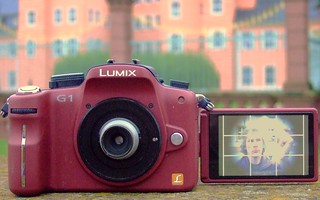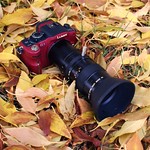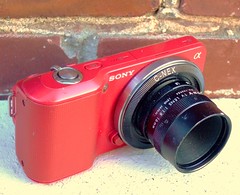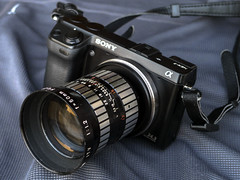Difference between revisions of "C-mount"
m |
m |
||
| Line 1: | Line 1: | ||
| − | The '''C-mount''' consists of a one-inch diameter cylinder threaded to a pitch of 1/32-in, or 32 threads per inch. | + | The '''C-mount''' consists of a one-inch diameter cylinder threaded to a pitch of 1/32-in, or 32 threads per inch. It was designed specifically for cine lenses used on 16mm cameras. |
{{Flickr_image | {{Flickr_image | ||
| Line 10: | Line 10: | ||
}} | }} | ||
| − | Some of the better quality cameras had a turret with a capacity for two or more lenses for making rapid changes in focal length. | + | Some of the better quality cameras had a turret with a capacity for two or more lenses for making rapid changes in focal length. Though [[zoom lens]]es were available in the 1940's, they were very expensive and involved some optical compromises, so were not widely used until they had achieved better and more consistent quality at lower prices. After this was achieved, they eventually came to replace the turret in the 1960's, particularly in cameras for the amateur film maker. The C-mount zoom lenses became dominating when some professional and amateur video cameras with C-mount appeared. |
| − | The "C" designation derives from the evolution of the mount from its "A" and "B" predecessors. All shared the same thread and diameter, but had different mounting depths; the three are not interchangeable. A-mount and B-mount lenses were used primarily on | + | When video camera design evolved to modern [[camcorder]] design the interchangeable lenses vanished, but a few C-mount lenses are still produced for the market of surveillance cameras and industrial process control cameras. |
| + | |||
| + | The "C" designation derives from the evolution of the mount from its "A" and "B" predecessors. All shared the same thread and diameter, but had different mounting depths; the three are not interchangeable. A-mount and B-mount lenses were used primarily on Filmo cameras of [[Bell & Howell]]. The cine camera and lens maker began to feature interchangeable lenses earlier than its concurrents like Victor. | ||
{{Flickr image | {{Flickr image | ||
| image_source=http://www.flickr.com/photos/mr_wood/3921992363/in/pool-camerawiki/ | | image_source=http://www.flickr.com/photos/mr_wood/3921992363/in/pool-camerawiki/ | ||
| Line 21: | Line 23: | ||
| image_rights= non-commercial | | image_rights= non-commercial | ||
}} | }} | ||
| − | + | Thread depths varied from maker to maker, but the proper A-B-C distinction lies not in the total thread depth but in the distance from the flange seat of the lens barrel to the innermost thread. The C-mount eventually became the standard mount for higher-quality amateur 16mm cine cameras. | |
| − | + | Cine cameras were often equipped with superb C-mount optics made by renowned lens makers like [[Taylor-Hobson]], [[Dallmeyer]], [[Meyer]], [[Angénieux]], [[Elgeet]], [[Berthiot]], and [[Schneider]]. [[Wollensak]] and [[Kodak]] also made some fine cine lenses. | |
| − | + | {{brl}}{{Flickr_image | |
| + | |image_source= http://www.flickr.com/photos/uwe_kulick/10888450494/in/pool-camerawiki/ | ||
| + | |image= http://farm8.staticflickr.com/7423/10888450494_48b153e4cb_n.jpg | ||
| + | |image_align= right | ||
| + | |image_text= [[Wollensak]] Velostigmat adapted to G1, the first µ4/3 [[CSC]] | ||
| + | |image_by= Uwe Kulick | ||
| + | |image_rights= wp | ||
| + | }} | ||
| + | ===C-mount revival=== | ||
| + | |||
| + | In this century, people have begun to experiment with C-mount lenses on digital (still) cameras, a trend boosted by the launch of the [[Micro Four Thirds|µ4/3]] cameras which have an appropriate flange/sensor distance to allow adaption of the 16mm cine lenses. | ||
| + | |||
| + | Similar new [[CSC]] lens mounts which followed like the [[Sony NEX]], Nikon CX, [[Pentax Q]] or EOS M mounts allow C-mount lens adaption too. Lens adaptors are widely available except for Samsung's mount. | ||
| + | |||
| + | {{Flickr_image | ||
| + | |image_source= http://www.flickr.com/photos/uwe_kulick/11052902905/in/pool-camerawiki/ | ||
| + | |image= http://farm4.staticflickr.com/3799/11052902905_732c999167_q.jpg | ||
| + | |image_align= left | ||
| + | |image_text= video [[zoom lens]] on G1 | ||
| + | |image_by= Uwe Kulick | ||
| + | |image_rights= wp | ||
| + | }} | ||
| + | |||
| + | It's likely to find the older uncoated lenses more satisfactory for [[bokeh]] experiments. Zoom lenses made for C-mount are a bit bulky and heavy but may be attractive for videographers who use for example a Panasonic Lumix GH µ4/3 since many are much faster than the original [[CSC]] zoom lenses. Meanwhile, the image circle of many lenses is unlikely to cover the entire area of the image sensor without serious [[vignetting]] since 16mm frame size is smaller than a µ4/3 sensor. Especially [[wide-angle]] C-mount lenses covering the whole sensor are very rare. The C-mount enthusiast will have to crop many images and videos shot with C-mount lens. | ||
| + | |||
| + | {{Flickr_image | ||
| + | |image_source= http://www.flickr.com/photos/89864432@N00/10577889134/in/pool-camerawiki/ | ||
| + | |image= http://farm4.staticflickr.com/3757/10577889134_1ab87801df_m.jpg | ||
| + | |image_align= left | ||
| + | |image_text= Sony TV LENS 1:1.8 16mm does well with<br/>NEX-3's sweep panorama mode which <br/>delivers just a cropped image height | ||
| + | |image_by= Uwe Kulick | ||
| + | |image_rights= wp | ||
| + | }} | ||
| + | {{Flickr_image | ||
| + | |image_source= http://www.flickr.com/photos/98922823@N00/9639763586/in/pool-camerawiki/ | ||
| + | |image= http://farm6.staticflickr.com/5345/9639763586_1bd2e6a85b_m.jpg | ||
| + | |image_align= left | ||
| + | |image_text= Fujinon ITV 1:1.2 f=50mm covers [[APS-C]] | ||
| + | |image_by= Paulo Moreira | ||
| + | |image_rights= wp | ||
| + | }}{{br}} | ||
==Links== | ==Links== | ||
Revision as of 10:24, 26 November 2013
The C-mount consists of a one-inch diameter cylinder threaded to a pitch of 1/32-in, or 32 threads per inch. It was designed specifically for cine lenses used on 16mm cameras.

|
| common 1950s amateur 16mm cine camera; lens turret with 3 viewfinder lenses and 3 C-mount taking lenses image by matias_e (Image rights) |
Some of the better quality cameras had a turret with a capacity for two or more lenses for making rapid changes in focal length. Though zoom lenses were available in the 1940's, they were very expensive and involved some optical compromises, so were not widely used until they had achieved better and more consistent quality at lower prices. After this was achieved, they eventually came to replace the turret in the 1960's, particularly in cameras for the amateur film maker. The C-mount zoom lenses became dominating when some professional and amateur video cameras with C-mount appeared.
When video camera design evolved to modern camcorder design the interchangeable lenses vanished, but a few C-mount lenses are still produced for the market of surveillance cameras and industrial process control cameras.
The "C" designation derives from the evolution of the mount from its "A" and "B" predecessors. All shared the same thread and diameter, but had different mounting depths; the three are not interchangeable. A-mount and B-mount lenses were used primarily on Filmo cameras of Bell & Howell. The cine camera and lens maker began to feature interchangeable lenses earlier than its concurrents like Victor.

|
| Schneider 1:1.5 25mm Xenon on Micro 4/3 adapter image by mr. Wood (Image rights) |
Thread depths varied from maker to maker, but the proper A-B-C distinction lies not in the total thread depth but in the distance from the flange seat of the lens barrel to the innermost thread. The C-mount eventually became the standard mount for higher-quality amateur 16mm cine cameras.
Cine cameras were often equipped with superb C-mount optics made by renowned lens makers like Taylor-Hobson, Dallmeyer, Meyer, Angénieux, Elgeet, Berthiot, and Schneider. Wollensak and Kodak also made some fine cine lenses.

|
| Wollensak Velostigmat adapted to G1, the first µ4/3 CSC image by Uwe Kulick (Image rights) |
C-mount revival
In this century, people have begun to experiment with C-mount lenses on digital (still) cameras, a trend boosted by the launch of the µ4/3 cameras which have an appropriate flange/sensor distance to allow adaption of the 16mm cine lenses.
Similar new CSC lens mounts which followed like the Sony NEX, Nikon CX, Pentax Q or EOS M mounts allow C-mount lens adaption too. Lens adaptors are widely available except for Samsung's mount.

|
| video zoom lens on G1 image by Uwe Kulick (Image rights) |
It's likely to find the older uncoated lenses more satisfactory for bokeh experiments. Zoom lenses made for C-mount are a bit bulky and heavy but may be attractive for videographers who use for example a Panasonic Lumix GH µ4/3 since many are much faster than the original CSC zoom lenses. Meanwhile, the image circle of many lenses is unlikely to cover the entire area of the image sensor without serious vignetting since 16mm frame size is smaller than a µ4/3 sensor. Especially wide-angle C-mount lenses covering the whole sensor are very rare. The C-mount enthusiast will have to crop many images and videos shot with C-mount lens.

|
| Sony TV LENS 1:1.8 16mm does well with NEX-3's sweep panorama mode which delivers just a cropped image height image by Uwe Kulick (Image rights) |

|
| Fujinon ITV 1:1.2 f=50mm covers APS-C image by Paulo Moreira (Image rights) |